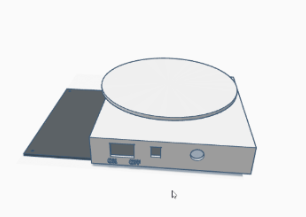Motorized turn table

Photobooth 360This project is based on a motorized turn table which uses a motor to move the table at a 360-degree angle.
In this project we learned how to make a motorized turn table, we have developed this project with the help of a circuit. The motive of this project by our Manaskriti minds was to develop a cheaper way to help and motivate the small vendors out there in our country, to display their products in the market. Our teacher, Tripti Maam has helped us in developing our design and explaining us the function of our plot.
Materials we used and their function:
The materials we used to make our project a success were:
Motor: A motor is a device or machine that converts electrical energy into mechanical energy, typically through the generation of rotational motion. Motors are commonly used in various applications, such as in electric vehicles, industrial machinery, household appliances, and more, to perform tasks like driving, pumping, or turning.
Barrel Jack: A barrel jack, also known as a DC power jack or coaxial power connector, is a type of electrical connector commonly used for supplying direct current (DC) power to electronic devices.
Power adapter: A power adapter, also known as a power supply or AC adapter, is a device that converts electrical energy from one form to another to provide the required voltage and current for operating electronic or electrical devices. It typically takes alternating current (AC) power from a wall outlet and transforms it into direct current (DC) power suitable for powering various consumer electronics, such as laptops, smartphones, and other gadgets.
PWM Regulator: A PWM (Pulse Width Modulation) regulator is an electronic device or circuit that uses PWM to control the output voltage or power of a system. PWM regulators are known for their efficiency since they can rapidly switch the power on and off, allowing precise control of the output voltage.
Switch: A switch is a mechanical or electronic device that is used to open or close an electrical circuit, thereby controlling the flow of electrical current.
